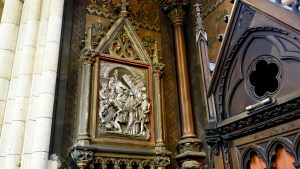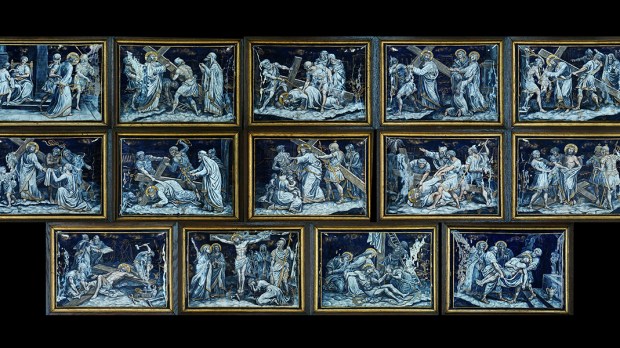Throughout the centuries, one of the most popular devotions that has stood the test of time has been the Stations of the Cross (also known as the Way of the Cross or, in Latin, the Via Crucis). It consists of a number of “stations” along which an individual can retrace the footsteps of Jesus Christ during his Passion and death.
How did the Stations of the Cross originate?
According to an ancient tradition, the Blessed Virgin Mary visited the sites of Jesus’ suffering, death, and resurrection on a daily basis after his ascension into Heaven. Many other traditions also claim that Mary followed Jesus along the road to Calvary.
However, in performing this practice, the Blessed Mother did not create a popular devotion with prayers and specific “stations” to follow. She simply was trying to relive the powerful events of Jesus’ passion and hold them “in her heart,” contemplating the great sacrifice he made.
Passion Shrines
It wasn’t until a few centuries later, according to the Catholic Encyclopedia, that “a group of connected chapels were constructed as early as the fifth century, by St. Petronius, Bishop of Bologna, which were intended to represent the more important shrines of Jerusalem … These may perhaps be regarded as the germ from which the Stations afterwards developed, though it is tolerably certain that nothing that we have before about the fifteenth century can strictly be called a Way of the Cross in the modern sense.”
Franciscans in the Holy Land
By the Middle Ages, the Holy Land became a volatile area and pilgrims were not given easy access to the shrines of Jesus’ Passion. As a result, Franciscans and others throughout Europe began building chapels and shrines that replicated these sites in Jerusalem. In particular, Dominican priest Blessed Álvaro of Córdoba spread the devotion in Europe, beginning in Cordoba, where he erected small oratories similar in style to modern day stations.
According to Fr. William Saunders, “William Wey, an English pilgrim, visited the Holy Land in 1462, and is credited with the term ‘stations.’ He described the manner in which a pilgrim followed the steps of Christ.” The term became popular in the English language and eventually was applied to those scenes that were set up in churches.
By the 17th century the Franciscans wanted to begin erecting these “stations” within the church walls and asked Rome for permission. Additionally, they wanted the faithful to be granted the same indulgences that would have been given to those who traveled to Jerusalem. Pope Innocent XI recognized the need and granted their request, paving the way for the Stations of the Cross as we know them today.
As a result, historians can’t say there was one person in particular who was responsible for the Stations of the Cross. Various holy individuals throughout the centuries, beginning with the Blessed Virgin Mary, walked in the footsteps of Jesus Christ, contemplating his Passion and death. It is a beautiful tradition, one that has grown organically over the years.

Read more:
Why are there Stations of the Cross in (almost) every Catholic church?

Read more:
A Marian alternative to the Stations of the Cross

